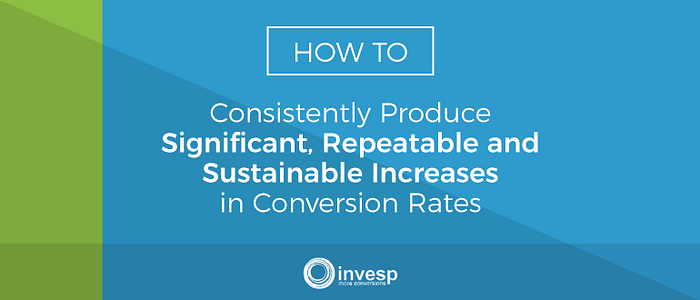- If you have been doing CRO for some time, you know it is not an easy task to produce consistent increases in your (or your clients') website conversion rates.
- There are months in which your A/B tests produce significant increases in conversion rates. In other months, you find not-so-great results.
- To build our conversion optimization practice, we introduced the conversion framework. But the framework is not enough in itself. How you implement the framework is where the secret lies.
- Back in 2005, I led the largest eCommerce implementation for Motorola. When we launched the website, we had hundreds of thousands of people come, but less than 100 sales in the first month. This led to the beginning of Invesp.
- We started as a 2 man operation, as we grew, we brought in more specialists with the right skills but we needed a framework everyone can follow across every client project.
The Conversion Optimization System
- To successfully implement the framework, we created a 12-step process.
- This conversion optimization process is one we have tested across eCommerce websites, lead gen websites, SaaS, and affiliate websites. We have also tested this process in verticals such as consumer services, education, financial services, etc.
- The first step is to conduct a heuristic analysis. To conduct a heuristic analysis, the first step is to determine the 10 most common tasks a visitor takes on your website. This is usually done by four members of our team (more on this in the article).
- The second step is to conduct qualitative research. This is a crucial step because your site visitors get to tell you what's working and what's not working (more on this process in the article).
- The third step is to conduct quantitative research. This is where analytics come into play. Analytics provides a wealth of information on how visitors interact with the website and shows you where visitors are leaking (more details in the article).
- The fourth step is to conduct competitor analysis. As the name implies, you're checking out the competition, but the rule of thumb applies here. Check them out, but don't copy them (find out more in the article).
- Now it's time to proceed to the 5th step which is creating your conversion roadmap. In this stage, your fix right away list should be sent to the developers to attend to, while your test list should be prioritized (more on this in the article).
- The 6th step is to identify the problem areas on a page. Leading up to this stage, you've conducted a heuristic evaluation, you've run some polls, etc. Now, you need to look at heatmaps and session recordings to evaluate individual pages you want to optimize (more on this in the article).
- The 7th step deals with you analyzing the page using the conversion framework. We utilize the Conversion Framework to do a 360 analysis of the page to determine some of the issues we are seeing on the page. The framework evaluates every element on the page from the following areas (see the article for more details).
- The 8th step is to prioritize the problems on the page. To determine what problems should be fixed first on the page, we use two factors: Potential conversion rate uplift. Implementation cost (find out more in the article).
- Now, it's time to create a hypothesis. This is the 9th step. The hypothesis is a critical component to testing. Ultimately, you've done your homework and your research. You've selected the page and identified the problems on the page. Logically, the next step would be to come up with the solution (see the article for our template on coming up with the hypothesis).
- The 10th step is to implement the hypothesis using new designs. Creating a design that fulfills the hypothesis can be challenging sometimes. You must be careful that your new designs are driven by the hypothesis, otherwise, you will introduce variables you won't be able to account for in your results (find out more in the article on how we control the variables for our designs to stay in line with our hypothesis).
- Now it's time to conduct the A/B test. This is the 11th step. You split the page visitors between the old design and the new designs. You let your visitors judge the quality of the designs (see the article for more details on how we conduct A/b tests).
- The final step in the conversion framework process is to conduct post-test analysis. You ran your A/B test, it came to a conclusion, and you have a challenger that beat the original design. What is next? There are 3 questions to answer (see the article for the questions you need to ask yourself).
This is a short version of the original article written on the Invesp blog.

